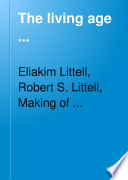 | 1897 - 918 pages
...separated by intervals relatively dark. The riddle of the nebulae was solved. The answer, which had come to us in the light itself, read: Not an aggregation of stars, but a luminous gas. Stars after the order of our own sun, and of the brighter stars, would give a different spectrum; the... | |
 | 1900 - 600 pages
...separated by intervals relatively dark. The riddle of the nebulae was solved. The answer, which had come to us in the light itself, read: Not an aggregation of stars, but a luminous gas. Stars after the order of our own sun, and of the brighter stars, would give a different spectrum; the... | |
 | George Iles - 1900 - 486 pages
...William Htiggins. This is what he saw : The riddle of the nebulie was solved. The answer, which had come to us in the light itself, read, Not an aggregation of stars, PLATK XVIII. THE NKHULA IN ORION. From the drawing by Professor GP Bond, 1859-^3. Pi ••* Xi.< 1... | |
 | 1902 - 230 pages
...William Huggins. This is what he saw: "The riddle of the nebulae was solved. The answer, which kad come to us in the light itself, read, Not an aggregation of stars, but a luminous gas. Stars after the order of our own sun, and of the brighter stars, would give a different spectrum, the... | |
 | Smithsonian Institution. Board of Regents - 1903 - 1122 pages
...separated by intervals relatively dark. The riddle of the ncbulat was solved. The answer, which had come to us in the light itself, read: Not an aggregation...luminous gas." With this advance a new era of progress begat). The power of the spectroscope to distinguish between a glowing gas and a mass of partially... | |
 | William Marshall Watts - 1904 - 414 pages
...sepa rated by intervals relatively dark. " The riddle of the nebulae was solved. The answer, which had come to us in the light itself, read : Not an aggregation of stars, but a luminous gas. Stars after the order of our own sun, and of the brighter stars, would give a different spectrum ;... | |
 | George Ellery Hale - 1908 - 480 pages
...separated by intervals relatively dark. The riddle of the nebulae was solved. The answer, which had come to us in the light itself, read: Not an aggregation...spectroscope to distinguish between a glowing gas and a starlike mass of partially condensed vapors established it at once in the place it still holds as the... | |
 | Richard Cockburn Maclaurin - 1909 - 324 pages
...separated by intervals relatively dark. The riddle of the nebulae was solved. The answer which had come to us in the light itself read : Not an aggregation of stars, but a luminous gas." Thus the spectroscope tells us something of the physical condition of a substance. It shows whether... | |
 | 1909 - 510 pages
...to the test of spectroscopic analysis. " The riddle of the nebulae was solved. The answer, which had come to us in the light itself, read : Not an aggregation of stars, but a luminous gas." The all prevailing hydrogen was there, and, as future researches have shown, its sympathetic companion... | |
 | 1909 - 518 pages
...to the test of spectroscopic analysis. " The riddle of the nebulae was solved. The answer, which had come to us in the light itself, read : Not an aggregation of stars, but a luminous gas." The all prevailing hvdrogen was there, and, as future researches have shown, its sympathetic companion... | |
| |